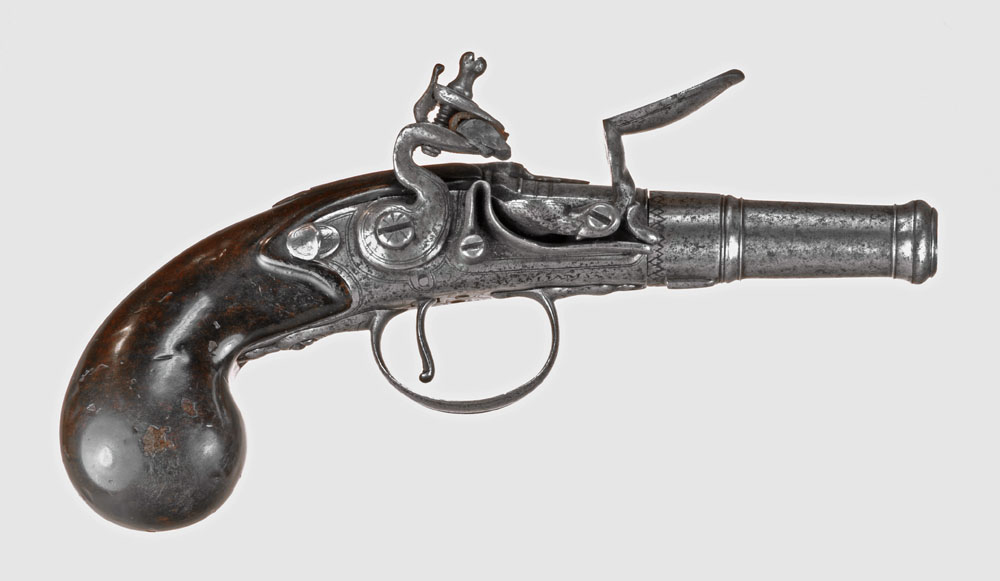Queen Anne pistol on:
[Wikipedia]
[Google]
[Amazon]
 Queen Anne pistols are a type of breech-loading
Queen Anne pistols are a type of breech-loading 



Pirate Living History 1680–1725
* Burgoyne, John W., The Queen Anne Pistol. Museum Restoration Service, 2002 {{ISBN, 0-88855-015-4 * Boothroyd, Geoffrey, The Handgun, Crown Publishers 1970 * Garrett, Richard, The Evolution of the Queen Anne Pistol. Catalogue of the London Park Lane Arms Fair, Spring 2005 Single-shot pistols Early firearms Black-powder pistols Weapons of the United Kingdom Anne, Queen of Great Britain
 Queen Anne pistols are a type of breech-loading
Queen Anne pistols are a type of breech-loading flintlock
Flintlock is a general term for any firearm that uses a flint-striking ignition mechanism, the first of which appeared in Western Europe in the early 16th century. The term may also apply to a particular form of the mechanism itself, also know ...
pistol
A pistol is a handgun, more specifically one with the chamber integral to its gun barrel, though in common usage the two terms are often used interchangeably. The English word was introduced in , when early handguns were produced in Europe, a ...
known as a turn-off pistol, in which the chamber
Chamber or the chamber may refer to:
In government and organizations
*Chamber of commerce, an organization of business owners to promote commercial interests
*Legislative chamber, in politics
*Debate chamber, the space or room that houses deliber ...
is filled from the front and accessed by unscrewing the barrel. Another distinguishing feature of the design is that the lock-plate and the breech section (chamber) of the firearm are forged as a single piece. Possibly first made in England, they came in fashion in England during the reign of Queen Anne (reigned 1702–1714) and are consequently so named. This type of pistol is noted for being made small, so that it could be easily carried and concealed. Carbines of this design are also documented.

Design
Queen Anne pistols areflintlock
Flintlock is a general term for any firearm that uses a flint-striking ignition mechanism, the first of which appeared in Western Europe in the early 16th century. The term may also apply to a particular form of the mechanism itself, also know ...
pistols with three defining characteristics. They have a turn-off barrel, typically with a swelled cannon muzzle, and are chamber-loaded. The body of the pistol (the breech) and the lock-plate are forged as a single piece. The frizzen spring is located to the rear of the frizzen rather than the conventional position, in front of it. To the last of these, this is a functional modification, such that the springs location does not obstruct removal of the barrel for loading. The lock-plate is integral with the body, and is sometimes described as a '' boxlock'' in consequence. It is nonetheless offset to one side with the mechanism assembled either side of the plate and is otherwise a conventional ''sidelock'' design. This is substantially different from the usual use of the term associated with Anson and Deeley patented shotgun design, where the firing mechanism is mounted ''within'' the frame of the firearm rather than off the sides of a lock-plate.
Queen Anne pistols are typically rifled. To load, the barrel unscrews (with the aid of a spanner) just in advance of the chamber
Chamber or the chamber may refer to:
In government and organizations
*Chamber of commerce, an organization of business owners to promote commercial interests
*Legislative chamber, in politics
*Debate chamber, the space or room that houses deliber ...
recess, that is filled with powder. The ball is placed in a conical seat (cup) at the end of the chamber before replacing the barrel. The breech end of the barrel is slightly enlarged to accept the ball. Upon firing, the ball fills the grooves of the rifling to create an effective seal.
The design was particularly suited to producing a small pistol that could be easily carried and concealed. They may be referred to as an ''overcoat'' pistol, a ''toby'' or a '' muff'' pistol. Queen Anne pistols usually exhibit a high level of decorative finish and workmanship.



Notes
Further reading
Pirate Living History 1680–1725
* Burgoyne, John W., The Queen Anne Pistol. Museum Restoration Service, 2002 {{ISBN, 0-88855-015-4 * Boothroyd, Geoffrey, The Handgun, Crown Publishers 1970 * Garrett, Richard, The Evolution of the Queen Anne Pistol. Catalogue of the London Park Lane Arms Fair, Spring 2005 Single-shot pistols Early firearms Black-powder pistols Weapons of the United Kingdom Anne, Queen of Great Britain